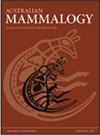小型哺乳动物在不同火灾间隔的低严重烧伤后的演替
IF 1.2
4区 生物学
Q3 ZOOLOGY
引用次数: 0
摘要
了解哺乳动物物种对计划中的烧伤的反应可以帮助保护区的管理者更好地实施哺乳动物保护的消防制度。在山地沼地,采用诱捕法研究了3种小型哺乳动物(鼠兔、褐毛鼠和小前鼠)对17年不同火灾间隔(6-9年和22年)的低严重程度连续计划烧伤的反应。烧伤后植被密度下降71 ~ 83%,小型哺乳动物基本消失至少2年。较短的火灾间隔时间(6-9年)比较长的火灾间隔时间(22年),植被恢复到燃烧前水平的速度较慢(7-10年以上,而4-5年),这与小叶蝉的恢复速度较慢和减少有关,而与木犀草和fuscus无关。这项研究表明,这些物种对中等生产力土壤上的山地沼地的小规模、低严重程度的计划燃烧有弹性,只要火灾间隔不太短(<10年)。需要进一步的研究来补充这些发现,并调查沼地中小型哺乳动物的反应,这些沼地的土壤生产力比这里研究的要低,那里的恢复时间预计会在更长的时间内发生。本文章由计算机程序翻译,如有差异,请以英文原文为准。
Small mammal succession following low severity planned burns with different fire intervals
Understanding how mammal species respond to planned burns can assist managers of protected areas to better implement fire regimes for mammal conservation. I investigated the response of three small mammal species (Rattus lutreola, Mastcomys fuscus and Antechinus minimus) to low severity, consecutive planned burns with different fire intervals (6–9 and 22 years) over 17 years, using live-trapping in montane moorland. Following the burns, vegetation density decreased by 71–83% and the small mammal species were largely absent for at least 2 years. Vegetation recovery to pre-burn levels was slower (7–10+ years versus 4–5 years) following burns with short fire intervals (6–9 years) than long fire intervals (22 years), and this was associated with a slower and reduced recovery for A. minimus but not for R. lutreola and M. fuscus. This study suggests that these species are resilient to small scale, low severity planned burns in montane moorlands on moderate productivity soils provided fire intervals are not too short (<10 years). Further studies are required to augment these findings and to investigate small mammal responses in moorlands on less productive soils than those studied here, where recovery times are expected to occur over longer timeframes.
求助全文
通过发布文献求助,成功后即可免费获取论文全文。
去求助
来源期刊

Australian Mammalogy
ZOOLOGY-
CiteScore
2.50
自引率
8.30%
发文量
26
期刊介绍:
Australian Mammalogy is a major journal for the publication of research in all branches of mammalogy. The journal’s emphasis is on studies relating to Australasian mammals, both native and introduced, and includes marine mammals in the Antarctic region. Subject areas include, but are not limited to: anatomy, behaviour, developmental biology, ecology, evolution, genetics, molecular biology, parasites and diseases of mammals, physiology, reproductive biology, systematics and taxonomy.
Australian Mammalogy is for professional mammalogists, research scientists, resource managers, consulting ecologists, students and amateurs interested in any aspects of the biology and management of mammals.
Australian Mammalogy began publication in 1972 and is published on behalf of the Australian Mammal Society.
 求助内容:
求助内容: 应助结果提醒方式:
应助结果提醒方式:


